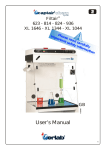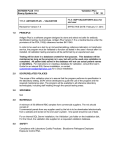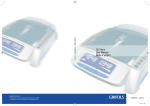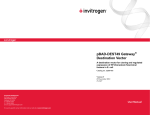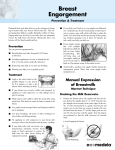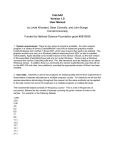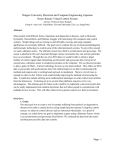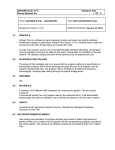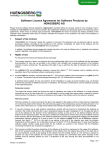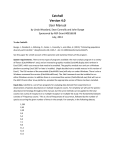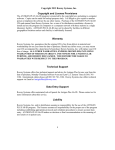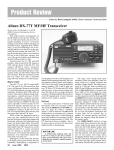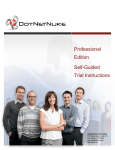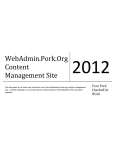Download Technical Report Writing-2
Transcript
Technical Report Writing-2 Dr. Nadia Mahmoud Maysarah Dr. Mohammed Al-Gayyar GEN 310 1 Report Is a structured written presentation directed to interested readers for a specific purpose, aim or request A report should be 1. ACCURATE True facts, precise wording, supporting data, reference to sources 2. CONCISE All the important ideas in as few words as possible Avoid repetitions 3. CLEAR Easy to read Clear organisation of the text: sections, subsections, headings, subheadings, paragraphing, numbering…. Do not use too long sentences 4. OBJECTIVE Content: include all the relevant information (do not be biased) Impersonal style (e.g. absence of emotional words, use of passive?,...) Good report: Good report should clearly motivate and define the problem, describe the approach and compare it to other approaches, present and discuss the results. Writing a report is a skill, that can’t be summarized in a set of rules, but like any craft can be learnt mainly through lots of practice and feedback. Different types of reports 1. Technical-background reports Is the most frequently written type of technical report It provides detail about a particular topic. e.g. mobile phone, coastal erosion, DU campus. 2. Instruction leaflets and manuals Take the form of a user manual for an appliance or a procedure. e.g. small insert included with a product (as pamphlet), detailed instructions for setting up production lines. 3. Laboratory report: Describe an experiment that has been undertaken. 4. Primary research report Describe experiments and surveys. Extend the laboratory report by explaining the background to the experiment, 2 methodology and the facilities. 5. Feasibility report It details findings such as whether the project is technically possible and feasible. 6. Proposals As a student: write a short proposal as an assessed piece of coursework 7. Business plan Plans for starting a business venture or extending an already established business. Contain information about proposed business, market place, anticipated share of the market and financial issues Planning to write a report Consider the following 1-Establishing the purpose Is written with the intention of achieving some objective Based on practical work, industrial or business situation Is to investigate, present and analyze information thoroughly and logically Recommend action to solve a problem Is usually to make proposals 2-Reader Is established in the topic and is often a client or manager It is necessary to identify the needs of the readers Awareness of the reader to determine how much background information needs to be given in the report Bridge the gap between the readers background knowledge and their needs Awareness of the readers helps to determine the choice of vocabulary, degree of details and tone of report 3-Investigating Past Knowledge This may involve a literature review and interviews with key people. We recommend that you: Prepare your reading list, making sure you find out if you need to get information from sources other than books and articles. Collect your information. Consider interviewing or talking to people who are involved. (Avoid "hearsay") You can also check collected brochures and pamphlets. 4-Obtaining New Evidence You may need to do some of the following: 3 -Carry out experiments. - Carry out calculations -Collect data. - Carry out a design. -Visit a site. - Conduct interviews. 5-Conclusions and Recommendations You should be thinking about making conclusions and/or recommendations. You must consider what will be most important for the readers. Typical report structure A system of numbered sections with headings is used Title page Abstract Introduction - Review of literature - Aim of present research Methodology - Materials - Procedures Results Discussion Conclusions and recommendations References Title page The title page should accurately describe your work and inform a potential reader of the content. It contains the following elements: The full title of the report – informative but not too long The name of the person for whom the report has been prepared The name of the person(s) who has written the report and ID number(s). Module code and the course name. The date the report is issued Summary or Abstract The most important page in the report – it must be written so as to encourage the reader to read further Should be written after the rest of the report has been written Keep it short, make it concise, interesting and informative It should include the purpose of the report, what you have done, how you did it, the main findings, the conclusions that were reached and any recommendations. 4 Introduction It should include the following: 1- General background (review of literature) to the subject area of the report with references made to others who have worked in the area. This enables you to show that you have read about your subject and are aware of current work. 2- Purpose (aim) of the present research Main body of the report The main body of the report is likely to contain a methodology, results or findings and a discussion Methodology This section describes: How you carried out your work Results or findings It includes the following: 1- Findings as concisely and clearly as possible with little discussion or analysis 2- Graphs, tables and figures. Discussion This section discusses the results. (if results are anticipated or unexpected) Analyze data and interpret results If there are any unexpected results, you should suggest reasons. Do not make any exaggerated claims about your findings Present a realistic interpretation of your results, and, link them to the purpose Compare your findings to those of others Show that you have done what was required Conclusion This part is for busy readers and for readers who want to read an overview of the findings before deciding whether to read the findings in detail (Summarize the entire work). Point out what you have achieved. Explain how your results address the task. It reviews the main results It draws a main conclusion and links to the recommendations by showing a need for action Recommendations You may make recommendations for future work; this is particularly useful if your own results were inconclusive What did not work and what to do about it What aspects of design may need improvement 5 References The references section is the final part of your report Use citations to refer to material that you have used in obtaining your results. All references have to be listed in the bibliography at the end of your paper. Why should I include references in my work? It shows the range of reading that you have done Support your argument. It is a basic academic requirement System used for writing references: The Harvard referencing system Books Author (date of publication). Title. Volume. Edition. Place of publication: publisher. e.g. Merriam, J.L. (2003) Engineering Mechanics. Vol.1: Statics. 5th Ed. Hoboken, N.J.: Wiley Journal Articles Author (year) article title. Journal title. Volume. Issue. Page numbers Kushner, G. B. (2005) Changes Ahead in Health Care. HR Magazine, Vol 50, No 13, pp. 60-61. Websites Author. Title. Full address of the web page and also the date on which you accessed the page Barger, J. (2000) A biography of Leopold Paula Bloom http://www.Robotwisdom.com/jaj/ulysses/bloom.html [accessed 11/07/2006] Acknowledgements This is where you acknowledge any help and support you have received whether from your supervisors, colleagues or external bodies. Appendix Anything that can’t be left out, but is too large for the main part of the report and would serve to distract or interrupt the flow of the report. It includes: Large tables of data Detailed explanations and descriptions of used techniques If more than five symbols, abbreviations or acronyms are used in the report, they are to be listed with their explanations 6 Layout, presentation and style of writing Guidelines for the Layout To facilitate reading of your report, it should be well laid out in a structured and wellorganized manner. Check with your department, supervisor or lecturer for any specific requirements regarding margin width, line spacing and choice of font. You should be consistent with your layout throughout the whole of your report. 1-Page Layout It is usual to break down your contents into sections and subsections of up to three levels. This enables the reader to go directly to a section that is of particular interest to him 2-Text Formatting 2.1 Main Text It is suggested to use a serif font for all your text, 12 or 14 pt. Times New Roman is a frequent choice for technical writers. (Avoid using italic or bold face in the body of your text). Use paragraphs to structure your ideas. As a rule of thumb: each idea should be dedicated to one paragraph. Try to use short and precise sentences. Split longer sentences into multiple shorter ones. 2.2 Headings Headings should be clearly identified (slightly larger font, bold face) and numbered. It is suggested to use up to three levels of numbering for documents of 20 pages or less and to use up to 4 levels for all other documents. 3- Tables Tables are numbered consecutively throughout the report (short paper) or within each main section (long document). Tables must have a caption. It is customary to centre the table number and its description and place this above the table. All tables must be given an appropriate and meaningful title. 4- Figures Figures are numbered consecutively throughout the report or within each main section. Figures must have a caption. It is customary to centre the figure number and its description and place this below the figure. In the case of graphs it is important to label axes, state the units you are using and apply a sensible scale to ensure that intermediate values can easily be determined 7 Tables and Figures Each table and figure should have at least one cross-reference to it in the text. It is customary to refer to the table or figure by its given number rather than the table below or above Tables and figures are presented in the text at a convenient position for both layout and viewing in relationship to the text that they relate to or they may be placed at the end of the report (it is more convenient for your readers if they are placed close to the relevant text). 5- Equations Equations are consecutively numbered or numbered within each section and referred to in the text. N.B. Bullet points (if not over used) are useful as they clearly convey important points to the readers. If the report is to be bound, so the left hand margin should be large enough to allow for binding. 6- Index For documents of 20 pages or more, you should include a table of contents. For documents of pages 40 and more you should also give a list of figures and tables. A glossary might be helpful if you use a significant number of abbreviations or terms you assume the reader is not familiar with. Presentation Arial font is generally used for text in memos, e.mails and examination papers, however equations and Greek characters are presented in Times New Roman. (It may be departmental requirements) Determine size of font and line spacing. If there are not any specifications it is suggested to use 12 pt font with single line spacing. Ensure that the first time you use an abbreviation or acronym the full description is given If many abbreviations or technical terms are used it will be helpful to include a glossary. 8 Plagiarism and paraphrasing References have to include at least title and authors name as well as some information on how and where to obtain the document ( e.g. publisher ,journal title , pages ) . You must also give information on the date of the publication. Use citations to refer to material that you have used in obtaining your results. Always cite (i.e. give a reference) to other related work or facts/opinions that you quote Never pass off the work of others as your own – this is plagiarism and is a very big academic crime!! Plagiarism If you do not indicate the sources of your ideas, it could appear that you are wrongfully claiming another author’s ideas or words to be your own This is known as plagiarism Never take the work of others without giving proper credit Never take verbatim sentences/paragraphs from the literature If you feel that you must use verbatim material, use quotation marks and a reference. COMMON TYPES OF PLAGIARISM Cut & Paste Plagiarism Whenever you take an entire sentence or significant phrase from a source, you must use quotation marks and reference the source. Word Switch Plagiarism If you take a sentence from a source and simply change around a few words, it is still plagiarism. Style Plagiarism If you follow a Source Article sentence-by-sentence or paragraph-by-paragraph, it is plagiarism, even though none of your sentences is exactly like those in the Source article or even in the same order. You are copying is the author's reasoning style. Other types of academic dishonesty 1. Collusion : Allowing work to be copied by another student , Copying another student’s work with their knowledge , Doing another student’s work for them 2. Falsification : Fabricating references or a bibliography , Inventing/Altering data 3. Copying : Copying another student’s work without their knowledge 4. Cheating : Not contributing a fair share to group work 5. Plagiarism : 9 Paraphrasing material from a source without acknowledging the original author Copying material for a report – without acknowledging the source Lifting information form the Internet without sourcing it Submitting work from an outside source How to avoid plagiarism Develop a system to record bibliographic information for all sources you use Take careful notes and develop a system to distinguish: - Text you have copied from the source - Text you have paraphrased or summarised - Your own ideas Compile your reference list as you write your assignment Get into the habit of paraphrasing appropriately Quotation Quotation : to put the exact words between Quotes. PARAPHRASING say it in your own way Structure: the grammatical structure should be changed if this can be done without changing meaning. Often this can be done by joining up sentences or by dividing up long sentences. Meaning: your paraphrase must have the same meaning as the source; it should also have the same relationship between main ideas and supporting details. Words: use different vocabulary when possible, usually more common synonyms/expressions and simpler phrases. Keep specialized vocabulary which has no synonyms (e.g., calcium; plastic; theory; neutron), proper names (e.g., Europe; World Health Organization), numbers and formulae (e.g. 50%; 1984). Length: the length should not vary very much from the length of the original. Style: should be your own and not an imitation of the source, even if your own style seems less perfect to you. A GOOD PARAPHRASE IS…. Accurate (the ideas in the paraphrase are the same as in the source) Original (the language use is different from the source) Grammatically correct 10 You must cite a reference source when you use: a direct quote information expressed in your own words (i.e. paraphrase) statistics diagrams, tables, graphs , photos You do not need to cite a reference when you use: Your own personal experience or opinion Common knowledge Editing and Proofreading Is editing the same thing as proofreading? Not exactly. Although many people use the terms interchangeably, editing and proofreading are two different stages of the revision process. Both demand close and careful reading, but they focus on different aspects of the writing and employ different techniques. Editing Editing is what you begin doing as soon as you finish your first draft. You reread your draft to see, for example, whether the paper is well-organized, the transitions between paragraphs are smooth, and your evidence really backs up your argument. You can edit on several levels:1. Content:Have you done everything the assignment requires? If it is required to do so, does your paper make an argument? Is the argument complete? Have you supported each point with adequate evidence? Is all of the information in your report relevant to the assignment? 2. Overall structure :Are headings clear and concise? Does your report have an appropriate introduction and conclusion? Is your topic clearly stated in your introduction? Is it clear how each paragraph in the body of your report is related to your topic? Are the paragraphs arranged in a logical sequence? Have you made clear transitions between paragraphs? 3. Structure within paragraphs:Does each paragraph have a clear topic sentence? Does each paragraph stick to one main idea? Are there any extraneous or missing sentences in any of your paragraphs? Do the ideas hang together cohesively? 11 4. Clarity:Have you defined any important terms that might be unclear to your reader? Is the meaning of each sentence clear ? Is it clear what each pronoun (he, she, it, this, etc.) refers to? Have you chosen the proper words to express your ideas? 5. Style:Have you used an appropriate tone (formal, informal, persuasive, etc.)? Have you varied the length and structure of your sentences? Do you tend to use the passive voice too often? Does your writing contain a lot of unnecessary phrases? 6. Citations:Have you cited appropriately quotes, paraphrases, and ideas you got from sources? Are your citations in the correct format? Are there too many or too few quotations? Are the paraphrases in your own words? Proofreading You should proofread only after you have finished all of your other editing revisions. Proofreading means examining your text carefully to find and correct typographical errors and mistakes in grammar, spelling, and punctuations. Why proofread? It's the content that really matters, right? Content is important. But like it or not, the way a report looks affects the way others judge it. When you've worked hard to develop and present your ideas, you don't want careless errors distracting your reader from what you have to say. It's worth paying attention to the details that help you to make a good impression. Before You Proofread:1-Be sure you've revised the larger aspects of your text. Don't make corrections at the sentence and word level if you still need to work on the content. Proofread for only one kind of error at a time. If you try to identify and revise too many things at once, you risk losing focus, and your proofreading will be less effective. It's easier to catch grammar errors if you aren't checking punctuation and spelling at the same time. 2-Set your text aside for a while (15 minutes, a day, a week) :Some distance from the text will help you see mistakes more easily. 3-Eliminate unnecessary words before looking for mistakes. 4-Know what to look for. From the comments of your professors or writing on past report, make a list of mistakes you need to watch for. When You Proofread: Work from a printout, not the computer screen. (But see for computer functions that can help you find some kinds of mistakes.) 12 Read out loud. This is especially helpful for spotting run-on sentences, but you'll also hear other problems that you may not see when reading silently. Use a blank sheet of paper to cover up the lines below the one you're reading. This technique keeps you from skipping ahead of possible mistakes. Use the search function of the computer to find mistakes you're likely to make. Spell checkers have a limited dictionary, so some words that show up as misspelled may really just not be in their memory. In addition, spell checkers will not catch misspellings that form another valid word. If you tend to make many mistakes, check separately for each kind of error, moving from the most to the least important. For instance, read through once (backwards, sentence by sentence) to check for fragments; read through again (forward) to be sure subjects and verbs agree, and again. Circle every punctuation mark. This forces you to look at each one. As you circle, ask yourself if the punctuation is correct. Most people devote only a few minutes to proofreading, hoping to catch any glaring errors that jump out from the page. But a quick and cursory reading, usually misses a lot. It's better to work with a definite plan that helps you to search systematically for specific kinds of errors. Sure, this takes a little extra time, but it pays off in the end. 13 Medical Laboratory Report It is the report presented by the medical laboratory to the patient after taking a specified sample and analyze it upon request ordered by his physician. Medical Laboratory Report: A single page report that has the following structure: Lab details: Name of lab, name of Responsible person, address, phones, so on….. Patients details: Name of patient, age, date, name of the physician, so on.. Analysis results Comment and signature of the physician in charge. 14 Analysis results The structure of this part depends on the type of the analysis done. For example: 1- Urine Analysis :It will contain the following parts: Physical examination: including color, aspect, deposit and specific gravity. Chemical examination: including the results of analysis of protein, sugar, acetone, nitrite, bilirubin, blood, ......... Microscopic examination: including pus cells, RBCs, epithelial cells, fungi, bacteria, ........... The normal value for each one should be written. 2- Blood analysis :It will contain the following parts: Chemical examination: including the results of analysis ordered by physician like blood picture, protein, sugar, hormones, ..... Microscopic examination: including abnormal cells, RBCs , WBCs, . Microbiological examination : including bacteria ,virus , ...... 3-Stool analysis: It will contain the following parts: Physical examination: including color, aspect, consistency ,........ Microscopic examination: including blood, parasite ,worms, worm eggs , ............ 4-Tissues analysis: It will contain the following parts: Physical examination: including color, aspect, consistency ,.... Microscopic examination: including tumor cells , ........ How to Read and Understand Medical Laboratory Results: All laboratory reports must contain certain elements as:15 1-Patient name and ID number. These are required for proper identification and to ensure test results are linked to the correct patient 2- Name and address of laboratory. The laboratory where the test took place must appear on the form for accountability purposes 3- Test report date. This is the day the results were generated and reported to the ordering physician. Mandatory Elements Of Lab Reports-Specimens And Tests 1- Headings: Some basic headings include Hematology (the study of blood cell.) Chemistry (the study of certain chemical components found in the blood stream or tissues), Urinalysis (the study of urine and urinary sediments and components), Bacteriology/Microbiology (the study of bacteria that may be found in the body), Immunology (the study of the body's defense substances ,called antibodies), Endocrinology (the study of hormones), and Blood Banking /Immunohematology (the study of blood types and blood cell protein). 2- Specimen Source. This is critical because something like protein can be measured from multiple sources such as your blood or urine . 3-Date and time of specimen collection. Because some tests are affected by when the specimen was collected, this will appear on every report . 16 4 - Name of test performed. Although the name of the test will appear, it is often abbreviated. labtestsonline.org has a clear list of abbreviations for a variety of tests. 5-Test results. Results can appear in a number of different ways, depending on the test. The result can be shown as a number (i.e. in a cholesterol level scan), a positive or negative indication (i.e. in a pregnancy test), or in text (i.e. the name of bacteria taken from an infected site). Lab resorts that are abnormal will usually be highlighted in some way. An "L" may mean that the number is lower than the reference range or an "H" may mean it is higher than that. Results that are dangerously abnormal must be reported immediately to the physician and are usually marked with an asterisk. 6-Reference ranges. These are the sample population that is used to determine whether a test result is normal or abnormal. There are many factors that can within a reference range determine whether or not your results fall including your age and sex, overall level of stress, or a pregnancy . It is entirely possible to fall out of the reference range on a particular lab test despite being out of good health. You should consult your physician if you are concerned about a certain result. Flags : Flags are letters that ask for special attention to a lab result. 1-Common lab flags. These include C for Critical (sometimes it can stand for Comment), H for High, L for Low, CH for Critical High, CL for Critical 17 Low ,and D for Delta. A Delta value is a large and sudden change of a lab result from the previous test result. 2- No flag usually means a result is normal. Normal values can usually be found on the right hand side of the lab report. Your Rights 1- Obtaining a copy of the report. it is your right to get copies of those tests from the doctor or laboratory that administered them. 2-Reviewing information. Your doctor is required to explain any lab results to you during your scheduled consultation with him or her . 3-Never use your lab results to treat yourself. Lab results are only one part of a broad array of tools a doctor uses to diagnose and manage diseases or disease states. A full medical examination, images (X-Rays, CT Scans, etc.), patient history and other diagnostic tools help your physician . • Exercise: Write a medical laboratory report • Work individually 18






















